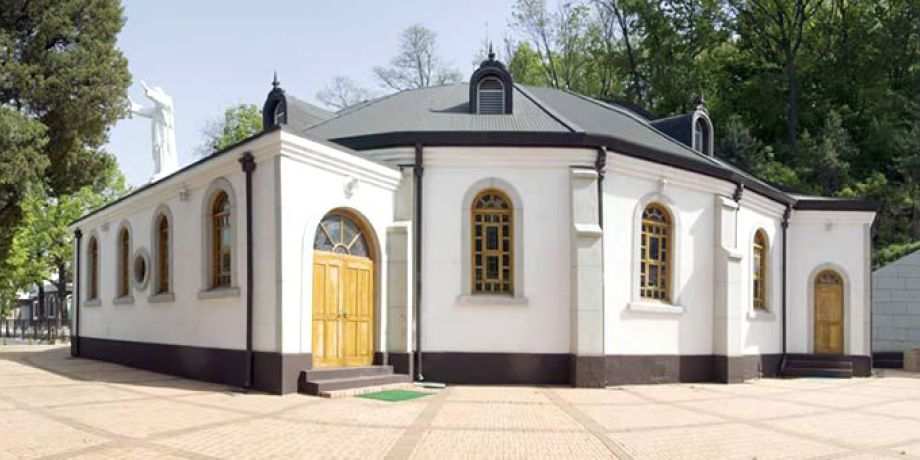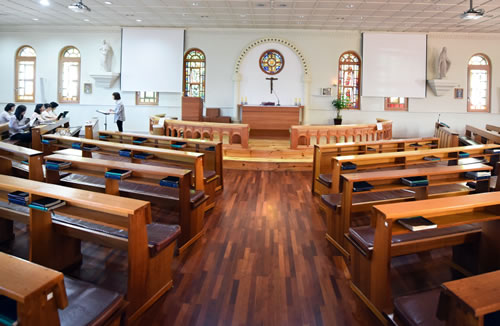
Formation House Field Trip
At the entrance to the chapel in the Columban formation house hangs a large picture that shows all the areas where Columban missionaries were martyred, including the photos of the seven priests martyred during the Korean War. A number of those priests are interred in the diocesan cemetery in Chunchon City, Korea. While I saw those photos every day I really did not know much about these martyrs. Recently however, together with our formation priests and other seminarians, I had the opportunity to visit the city of Chunchon where these men ministered and are now buried. To vist Soyangro and Chungrimdong churches we took the “springtime” train from Chungyanyri and arrived in Chunchon after a ride of one hour.

in honor of the martyred Columban Fr. Anthony Collier.
I found that the Soyangro church at the end of the steep road was cozier than I had imagined. Fr. Kim Hyunjun [Julio], the parish priest who had close connections with the Columbans from his youth, greeted us warmly and spoke in great detail about the history of the church. In 1956, Columban Fr. James Buckley, the third parish priest of the parish, built the present church in honor of the martyred Columban Fr. Anthony Collier. Fr. Collier was ordained a priest in Ireland in 1938 and arrived in Korea the following year. He served as a curate in Kangnung church [presently Imdangdong church] before becoming parish priest in Hwengsun. He was appointed the first parish priest of Soyangro in 1950. However, in that very year war broke out on June 25.
While he could have escaped, Fr. Collier decided not to leave the parish but to remain with his people to protect them. He continued to say Sunday Mass and to pray with the Catholics each evening. When the bombing raids became more severe he encouraged his curate and the Catholics to escape to safety and told them that he would remain to protect the church. On the afternoon of June 27 when the situation became worse and while he and his alter boy Kim Kyung-ho [Gabriel] together with his Sunday school teacher were on their way to Chungrimdong church they were questioned by members of the citizens’ army. They tied up Fr. Collier with ropes and dragged him along before fi ring the fi rst shot at him. They then proceeded to fi re two more shots at him. Fr. Collier lost his life right there and then. While this was happening Kim Gabriel and the Sunday school teacher were able to escape as they had not been tied up. At the age of 37, Columban Fr. Anthony Collier became the fi rst martyr in the diocese of Chunchon.
Soyangro church is built in a semicircle with the altar in the center and the seats fanning out around it which allows the believers to be very close to the priest celebrating Mass. While it is much smaller than the other churches in the city it has a special beauty that cannot be seen elsewhere. The atmosphere was such that I immediately felt like praying. Meeting the altar servers that had gathered around the church and seeing all the fl owers in the church yard as well as the nicely arranged stone signs to the martyrs and the general scene around the church, I could feel that even some 75 years afterwards, the Catholics still remember the late Fr. Anthony Collier and are praying that they might be able to imitate his faith. Another sign of this were the placards announcing special prayer meetings for the war martyrs.
We moved from there to visit Chungrimdong church. Columban missionaries served here also building the present church in 1956. This stonework church with its central tower is magnifi cent and unique. Behind the church is the diocesan cemetery where Fr. Anthony Collier and the seven martyrs of the Korean War are buried. Columban Frs. Frank Canavan, Patrick Reilly and James Maginn; Chunchon Diocesan priests Kim Kyo-myung (Benedict), Peck Ung-man (Thomas), and Lee Kwang-jae (Timothy). There is also the grave of Bishop Thomas Quinlan who was arrested by North Korean soldiers, forced to endure the “March of Death” and miraculously returned South. There is also a memorial grave for Bishop Thomas Stewart, the second bishop of the diocese as well as the graves of Frs. John Lynch and Thomas Comerford. There was a gentle breeze blowing and a warming sun shining that appeared to be welcoming us as we celebrated Eucharist in the graveyard.
On the return journey to Seoul I found that I was wondering why these priests left their homelands and spent their youth in this faraway foreign land of Korea, laying down their lives while fervently ministering here? I fi gured that these priests had experienced God’s love and mercy and wanted the believers to be able to have similar experiences.
As Jesus had a special place in the hearts of these missionaries, they longed for their believers to have the same. I began to look at my personal relationship with Jesus. I refl ected on what I needed to do as a believer to get to know Jesus better and to become more like Him. This trip to Chunchon was an important time for us students who dream of becoming missionaries and offered us a unique opportunity to grow a step closer to Jesus.
Kim Jin-uuk is a Columban seminarian.